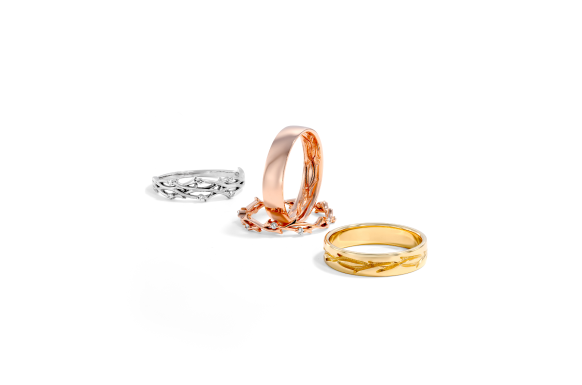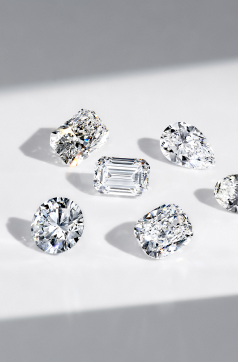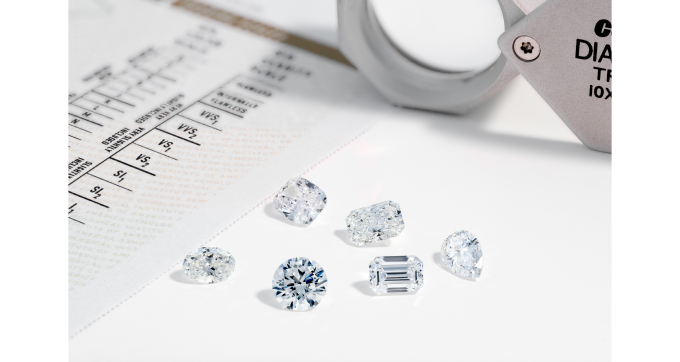4Cs - Clarity
Education Center
Education CenterEverything You Need to Know About Diamond Clarity
A diamond with outstanding clarity has few to no inclusions and blemishes. This doesn’t mean you must only shop for flawless stones and nothing else. It’s still possible to get a large, sparkly, eye-clean rock in lower clarity grades. Here at Keyzar, we’re all about sparkle, size, and saving money… Continue reading to learn about inclusions, blemishes, clarity grades, and more!
What exactly is diamond clarity?
Clarity refers to the presence of inclusions or imperfections within a diamond. Inclusions materialize within a diamond when tiny particles of gas, metal and dust are caught inside the structure as it grows. Blemishes affect the surface of the gem.
Diamonds with large inclusions and blemishes have poor clarity. Diamonds with small (or no) inclusions or blemishes have good clarity. The position, size and visibility of inclusions can have a huge impact on its clarity and price.
It’s important to note though: clarity has nothing to do with the brilliance and sparkle of a diamond. What could affect a stone’s sparkle factor is cut, which you can read more about under the ‘Cut’ article.
How does clarity affect cost?
Clarity can impact the price of a diamond, which tends to be a top consideration for most diamond buyers. Only the most rare and expensive diamonds have no inclusions. Unless you recently won the lottery, you may want to find out more about optimizing clarity and minimizing cost!
A more affordable way to get diamonds with little to no inclusions is to go lab-grown. Lab-grown diamonds still have inclusions, but you'll more easily find diamonds with high clarity grades at an affordable price point.
Diamond Clarity Grades
To determine the clarity of a diamond, the GIA (Gemological Institute of America) uses a diamond clarity scale, consisting of 11 grades:
|
Clarity grade |
Meaning |
|
Flawless (FL) |
No inclusions or blemishes using 10x magnification |
|
Internally flawless (IF) |
No inclusions using 10x magnification |
|
Very, very slightly included (VVS1 and VVS2) |
Slight inclusions barely visible to a skilled diamond grader using 10x magnification |
|
Very slightly included (VS1 and VS2) |
Small inclusions ranging from difficult to somewhat easy to identify by a grader using 10x magnification |
|
Slightly included (SI1 and SI2) |
Inclusions are visible with 10x magnification |
|
Included (I1, I2 and I3) |
Obvious inclusions using 10x magnification which might affect brilliance and transparency |
A diamond certificate reveals the clarity of the diamond (among other parameters). We display the color grade for each of our stones in our diamond catalog. The shorthand for different grades such as VVS1 or SI2 are used by jewelers all over the world, so it's worth understanding their meaning when shopping for a diamond.
No two diamonds are the same! It's crucial to examine a diamond closely before buying it using something like Keyzar's 3D preview tool. If inclusions are located in the table of a diamond, they will generally be easier to see. Even a small one could ruin your ring’s appearance.
Keep in mind that inclusions and blemishes may not be visible to the naked eye and only under the close inspection of a trained diamond-grader. Even if a trained eye were to find inclusions using a loupe, what matters most is that the stone is eye-clean. Many times, inclusions that are visible under a loupe are not visible to the naked eye.
Eye-clean: the only diamond clarity grade that (really) matters
A diamond that is 'eye-clean' is one that has no imperfections visible to the naked eye. This is the only thing you should be after (unless you’re a professional diamond trader). Spend your money on size, not on clarity. Go for the minimum clarity: eye-clean. SI1 diamonds are usually eye-clean but to make absolutely sure, use our 3D preview tool to see for yourself. If you go for a brilliant cut diamond, a below-SI1 clarity may not be an issue as the sparkle will obscure the inclusions and blemishes.
Low sparkle cuts like the Asscher generally need to have a higher clarity to avoid visible imperfections. For step-cuts, we don’t recommend going for clarity less than VS. If you want to splurge, we suggest doing so on cut; not on clarity.
Cut First, Clarity Later
If your cut is poor, it doesn’t matter how clean the diamond is. It’ll look lifeless and crummy. So don’t spend the bulk of your budget on clarity, allocate your budget mostly to cut and carat size.
Our advice is to aim for eye-clean diamonds in lower clarity grades. If you choose Keyzar, we recommend you to get in touch with us for advice on specific diamonds. We might help you save even more money by using prongs and bezels to hide light defects.
Conclusion
The good news is you don’t need to spend a fortune to find a high quality diamond with superb clarity and sparkle. You just need to consider the 4C’s: Cut, Clarity, Color and Carat Weight. Hopefully, you now have a better idea of how to find a beautiful diamond.



